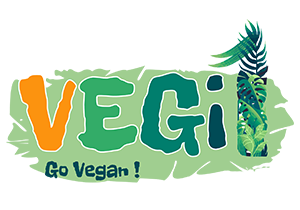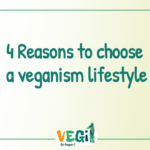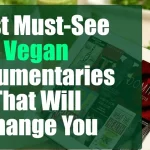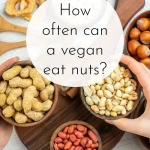How to Feed a Dog Vegan Diet: A Complete Guide
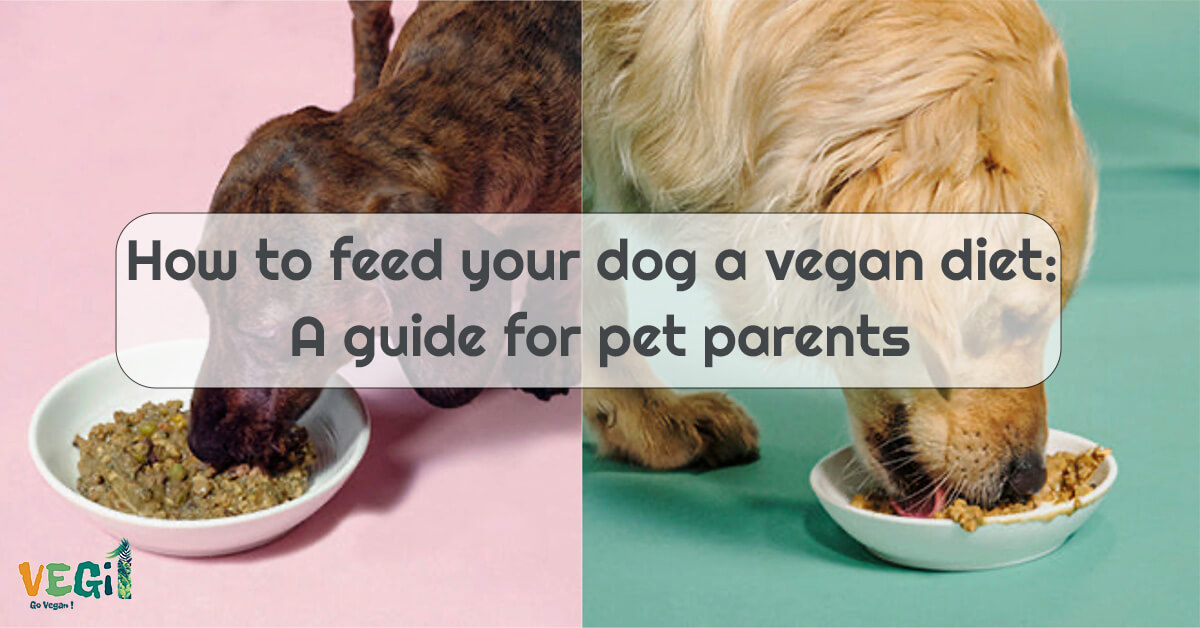
Animals existed many years before humans, and even after the evolution of humans, animals are still living in their natural habitats. After the evolution of humans and the increase in their population, animals were hunted as food to be eaten by humans; after that humans were able to live with some animals and named these animals domestic animals, as in real nature no domestic animals exist.
Dogs are one of the categories of animals that can live with humans. These animals are carnivores, and their owners usually have to use the meat of other animals to provide food for this furry animal.
With this situation, some dog owners who are vegan like me, in addition to not using any animal products, have the question of whether their pets can have a diet without animal products or not.
It is difficult to argue against the advantages of a vegan diet for people. A diet free of animal products is not only the healthiest option, but it also reduces the risk of heart, diabetes, obesity, disease, and a number of other issues that affect modern Americans.
Because vegan diets appear so healthful for people, Dog owners naturally question, “Can my dog become a vegan?” the short answer is, “It depends.” Continue reading to find out what nutrients dogs require, how vegan diets function, and whether or not you can feed your dog a vegan diet.
In this article you will read:
Why should I give my dog a vegan diet?
Today, people are more inclined to become vegan for reasons such as health, environment, ethics, and animal welfare.
Vegan people do not use any animal products to support animals and their lives and try to preserve animals and the earth’s environment.
More dog owners than ever are looking to feed their canines a vegan diet for the same reasons Because they want to prevent the killing of more animals for their meat and live without using any animal products.
Pet ownership produces a lot of carbon. That’s because it takes a significant quantity of natural resources to produce enough food to satisfy their diets that are high in meat. According to studies, pets contribute the same amount of carbon dioxide to the atmosphere each year—the equivalent of 64 million tons—as 13.6 million cars driving for a whole year.
This translates to an average-sized dog producing about 770 kg of CO2e annually when expressed in terms of CO2 output per dog. A huge dog generates an astounding 2,500kg of CO2e annually.
We now know that avoiding animal products can cut your carbon impact from food by about three-quarters, thanks to researchers at Oxford University. This means that while vegan food can be best for your dog’s health, it undoubtedly has less environmental impact.
In addition to providing all the needs of your pet, the vegan diet can have a lower impact on the environment and is animal friendly, so if you have ever doubted whether a vegan diet is the right choice or not, I say yes, definitely choose this diet for your pet.
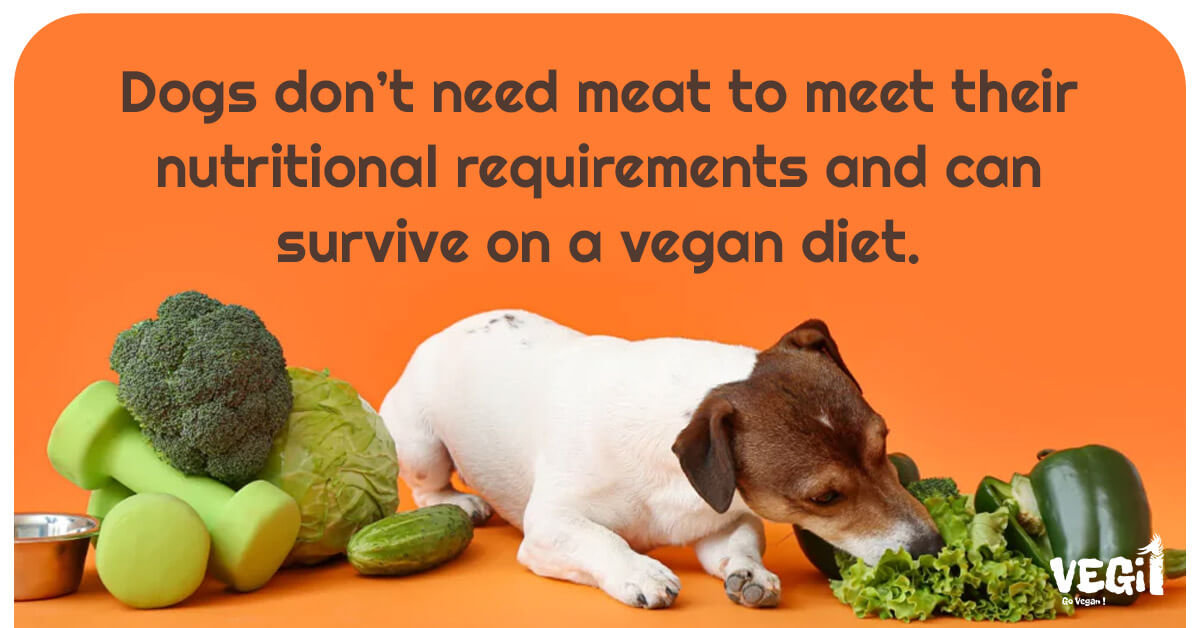
Do dogs need meat?
Dogs are omnivores, in contrast to their wolf forebears, who subsisted nearly completely on meat.
Because it contains amino acids, which are necessary for your dog’s body to function normally, protein is significant.
Dogs require 22 amino acids. The remaining 10 essential amino acids, which they must obtain from their diet, are 12 of which they can manufacture.
Protein in dogs serves the following purposes:
- The development and upkeep of wholesome cells, antibodies, hormones, tissues, and organs.
- Keeping their muscular mass
- Improving immunological function
- Repairing tissue damage and promoting better healing in areas like skin, muscle, bone, and hair
Both plant and animal protein sources contain these 22 amino acids. While high-quality proteins from animal sources do include all the important amino acids your dog requires, most plant foods can provide these essential amino acids.
However, it is normal that some plant sources do not have all the amino acids, so you can choose commercially prepared “complete” foods that have all the amino acids your dog needs to be healthy when you want to feed them a vegan diet.
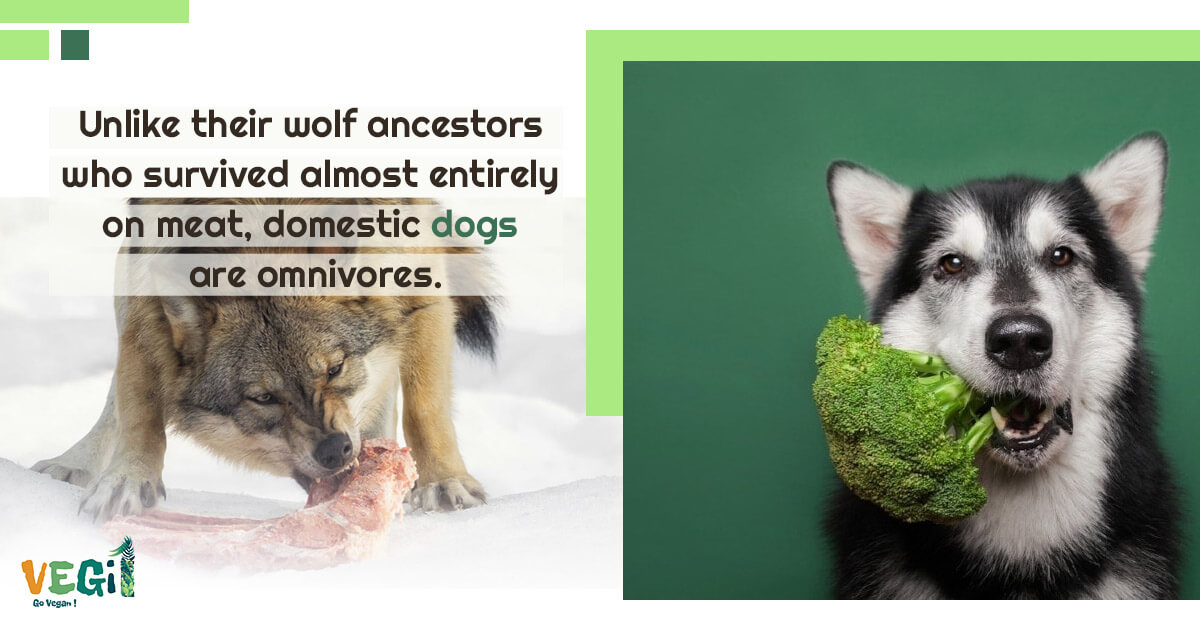
Can I feed a vegan diet to my dog?
Let’s get to the point quickly. Dogs can thrive on a vegan diet and don’t need meat to achieve their nutritional needs.
However, it doesn’t mean that it’s okay to just replace your dog’s typical meaty treats with a vegetable-based alternative. You must pay close attention to your dog’s dietary requirements if you want them to be healthy on a vegan diet.
It’s crucial to remember that a vegan diet can be dangerous for some dogs because some dogs may not be able to digest plant foods well.
Therefore, you should think about whether a plant-based diet is appropriate for your dog before switching them on to one. Before making such significant dietary changes for your pet, it’s crucial to speak with your veterinarian.
In general, all dog breeds can be fed a vegan diet, but some breeds may be better suited to this diet than others.
- Small dogs: Small breeds such as Yorkshire Terriers, Miniature Poodles, and Shih Tzus are usually suitable for a vegan diet. These breeds usually have a faster metabolism and need fewer calories.
- Active dogs: Active breeds such as the Scottish Highlander, Border Collie, and Australian Shepherd are usually suitable for a vegan diet. These breeds require a lot of energy and can benefit from a carefully designed plant-based diet.
- Mixed breed dogs: Mixed breed dogs are usually suitable for a vegan diet. These dogs typically have varied metabolisms and nutritional needs and can benefit from a carefully designed plant-based diet.
However, some dog breeds may not be suitable for a vegan diet. For example, large, sedentary breeds such as guard dogs may not respond well to a vegan diet.
Labrador Retriever, Golden Retriever, and German Shorthaired Pointer Carnivorous breeds:
- Hounds: Hounds are designed to hunt and chase animals. This makes them natural carnivores.
- Shepherd dogs: Shepherd dogs are designed to protect the herd from predators. This makes them natural carnivores.
- Guard dogs: Guard dogs are designed to protect the home and family from intruders. This makes them natural carnivores.
However, it is important to note that no breed of dog is completely carnivorous. Dogs can eat plants because they are omnivores.
Check with your vet for some vegan dog diet tips to make sure your dog’s diet is getting enough of all the essential nutrients.
- Use vegan dog food. These meals have been specially prepared to satisfy the dietary requirements of dogs.
- Give your dog food supplements. Vitamin B12 and some essential nutrients are insufficient in plant-based foods.
- Check your dog’s weight regularly to make sure it is at a healthy weight.
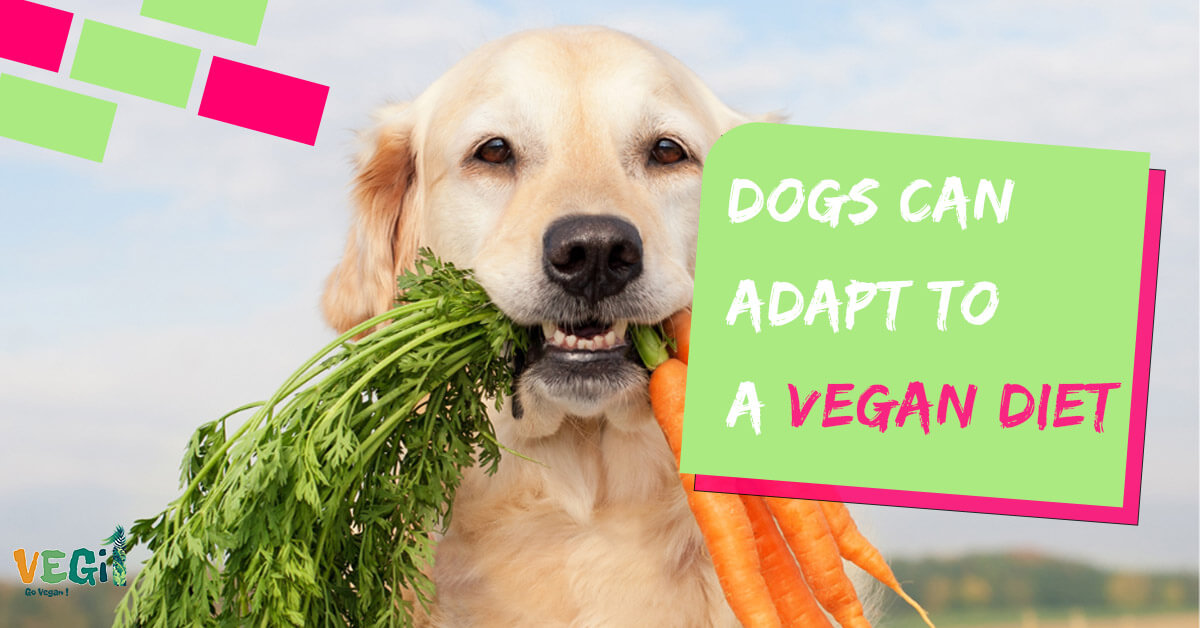
Problems that vegan pets may encounter
Dogs can consume a vegan diet. My research shows that an unbalanced vegan diet can result in a few serious deficiencies:
- Inadequate protein consumption (protein requirements vary by age and activity level in dogs; generally speaking, an adult dog’s diet should contain 15% to 30% protein)
- Unbalanced amino acids (can cause heart issues and other illnesses)
- A lack of vitamins and/or minerals (dogs need B vitamins, calcium, phosphorus, and iron, which are most frequently and effectively found in meat) may be to blame.
As long as your dog can digest high-protein meat substitutes like legumes and beans, protein levels can be adequately met with a plant-based diet.
The amino acids, however, present a greater difficulty. If you make vegan dog food at home, you’ll need to add supplements because vegan dog food sold commercially is formulated to make up for what’s missing without meat.
Proteins and vitamins needed by dogs
Canine non-meat protein can be just as beneficial as canine animal protein. Especially if the dog has allergies to meat proteins. Dogs can be fed a diet that is exclusively composed of plant-based proteins as long as the ratio of the available amino acids is correct. All 10 of the dog’s essential amino acids can be found in plant-based protein, but vegetables, legumes, and grains frequently need to be combined to provide the full range of the essential amino acids. The source of the protein does not matter to the health of the dog as long as the total intake of proteins is right and balanced.
Dogs require iron, calcium, phosphorus, vitamin B, and other nutrients, which are best absorbed from meat sources. For instance, vitamin B12 supports a dog’s healthy brain, cell, and nerve function. Its absence can cause extreme fatigue, appetite loss, quick weight loss, and even seizures.
The best vegan dog protein
Soybeans are a good plant-based protein source for dogs because they are one of the few plants with a complete amino acid profile.
Various other excellent sources of protein for dogs besides meat are green peas, lentils, beans, potatoes, rice, quinoa, and chickpeas.
Pea protein has a high level of protein and all ten essential amino acids, but because methionine and cysteine are insufficiently present, it falls short of being a complete protein. It is possible to supplement, though, for instance, with rice, which contains a lot of methionine and cysteine.
Beans, peas, lentils, chickpeas, and other legumes are rich sources of protein, fiber, vitamins, and minerals. In addition, they taste great and are much more climate-sustained than meat.
Mushrooms also have an umami flavor, which is often associated with meat.
Koji, a type of mushroom, is a complete protein that contains all nine essential amino acids as well as probiotics, digestive enzymes, and omega fatty acids to support gastrointestinal bacteria. It can be used to good effect in vegan dog food.
Here are some of the top canine vegan protein sources: tofu, tempeh, and seitan dark green vegetables like cabbage, spinach, and broccoli; peanut seeds like chia seeds and flax seeds; nutritional yeast / b-yeast soybeans peas, lentils, chickpeas, and beans. Koji and mycoprotein quinoa and potatoes
What dogs can eat and what they should not eat
Numerous vegan-friendly foods, such as the following, are safe for dogs to eat:
- broccoli, carrots, and other vegetables
- Rice,
- Quinoa,
- Lentils
- Certain kinds of beans (but keep in mind that beans generally cause flatulence in dogs)
- dark, leafy greens such as kale and spinach
Dogs should never eat a variety of plant-based foods, of course. For example:
- Natural peanut butter
- Onions
- Nuts
- Sugar substitutes
You should conduct extensive research before introducing a vegan diet to your dog. A vegan dog diet also needs to pay close attention to amino acids, vitamins, and minerals in addition to whole foods that are suitable for dogs. Nowadays, there are more commercially produced vegan dog foods available, which is a sensible choice because these foods have been designed to satisfy a dog’s nutritional needs.

Homemade Vegan dog food recipes
1) Azestfor’s Tofu with Black Eyed Peas and Rice
If you’re looking for a healthy dog food recipe to feed your dog who has multiple protein allergies, this simple homemade vegan recipe is a great option.
Black-eyed peas naturally contain lutein, an antioxidant that can reduce inflammation and soothe a dog’s irritated skin, in addition to making their tummies happy. These cowpeas, which are also heart-healthy beans, have no cholesterol and can ease constipation. For this recipe, cooking the black-eyed peas takes a significant amount of time.
I advise consuming two servings day of this homemade dog food for allergies, one in the morning and one in the evening. Because of their age and level of exercise, every dog has slightly different nutritional needs. If your dog is gaining weight, cut back on the food; if he or she is losing weight, increase it by 1/4 cup per day.
2) Unexpectedly Simple Dry Dog food
Although it is difficult to find and pricey, you can make your own dry vegan dog food. Although it is a lengthy process, it is fairly easy and simple. One recipe for dry vegan dog food that you can make for your dog is the one that is provided below. I prepared it using the dog-safe foods that we currently had on hand.
You can use the same techniques with your own custom ingredient blend for your pet and still achieve the same outcomes. In order to guarantee that your dog receives a diverse range of nutrients, I would even advise periodically altering the recipe. Additionally, you can learn more about preparing these homemade recipes.
Rice and dried beans should be prepared as directed on the packaging. In a big pot, combine beans, potatoes, carrots, and flax seeds.
Boil until the potatoes and carrots are soft. Let it cool. In a food processor, combine all ingredients and puree. Apply a thin layer of the mixture to a baking sheet that has been greased with coconut oil. Bake for 45 minutes at 350o F. Take out of the oven and turn. After 45 more minutes of baking, lower the heat to 300o F. Take out of the oven and split into pieces. Lower the temperature to 200ºF and bake the pieces for 30 to 60 minutes or until they are completely dry.
3) Easy Quinoa and Banana Smoothie
An excellent addition to your pet’s diet could be a homemade vegetarian dog food recipe. The dietary requirements of a 25-pound adult dog with no health issues and an average amount of exercise are the basis for this recipe. The daily serving size is roughly 1.75 cups of food. You should divide this amount into two meals a day at the very least.
Set oven temperature to 400°. Bake the sweet potato until it is tender by poking holes in it with a fork. This ought to take an hour or so. If you want faster results, you can also microwave it for about 5 minutes.
Boil the water, then add the quinoa while the potato cooks. Cook it until the water is completely absorbed. Additionally, you must boil the peas per the directions on the package.
Recipe for Homemade Vegetable Dog Food: Chop the sweet potato and slice the banana into pieces that are appropriate for your pet’s size.
4) Dogs’ Meatless Mush
With the increasing popularity of vegetarianism and veganism, many pet owners are curious if their dogs can follow these diets as well. For most dogs, this homemade meatless dog food is a healthy choice. To ensure balanced nutrition, it’s crucial to speak with a canine nutritionist regarding the supplements that will be required.
In a big pot, bring the water to a boil. Add the rice, quinoa, lentils, and sweet potatoes after they have boiled. After lowering the heat to low, simmer the ingredients for half an hour. Stir the food from time to time.
Take the recipe off the burner. Add the coconut oil, cranberry juice, apple cider vinegar, and peanut butter.
It will be simple to fully combine the homemade dog food without meat since the heat from the meal will melt the coconut oil and peanut butter.
You can feed your dog the food in accordance with the suggested serving sizes listed below once it has cooled.
5) Black-eyed Peas and Potato Stew by Active Vegetarian
In a large pot or bowl, add the peas and 4 cups of water. Soak overnight. Rinse and drain the peas. Put the peas in a big pot with six cups of water, then turn the heat up to medium-high. For about 45 minutes, or until peas are tender, cover the pan and lower the heat to a simmer.
Add more water if they are drying out before becoming tender.
Add the carrots, potatoes, and tofu shreds along with two cups of water. 25 minutes of simmering at medium heat. Remove from heat and let sit for ten minutes to cool. When everything is thoroughly combined, add the dulse flakes and hemp oil. Let cool completely before serving.
The way to store: The food leftovers can be frozen and kept for up to 3 months or kept in the refrigerator for 3-5 days in an airtight container.
Remember that this recipe won’t last nearly as long as store-bought dog food because it doesn’t contain any preservatives.
6) Quinoa, Tofu, and Bean
Bring water to a boil in a large soup pot. Add quinoa and rice. Cook the rice and quinoa for about 15 minutes, then cover and lower the heat. Cut the heat off. To allow the frozen veggies to steam a little bit, add them to the pot and cover it again. Give ten minutes for it to rest. Mix in the extra ingredients.
Ready-made vegan dog food
Rather than making vegan meals for your dog at home, I advise you to buy vegan dog food. This is because commercially produced vegan dog foods are complete and balanced, which means they contain all the vitamins, minerals, and other nutrients your dog needs in his diet.
Petaluma This brand of vegan dog food genuinely meets Cookie’s requirements and our standards for quality. This is the reason I’m thrilled to be a Petaluma customer and why I heartily suggest their kibble and treats.
In fact, the first vegan dog food we ever tried was from Wild Earth; their dry food is undeniably excellent, and Cookie thoroughly loved it.
Being the first vegan dog food company in the United States, I have to give this brand a lot of props. This kibble is fed to dogs by a few people I know, and both the dogs and their owners adore it.
Okay, so the fact that Bramble is a vegan dog food that is whole foods based and unprocessed—that is, without kibble—keeps me really interested in them! These are the reasons I would think about using them, but I would be more likely to just buy their “toppers” due to their high price. These can be mixed in with a regular kibble meal to add flavor and nutritional benefits.
Although Halo does not produce only plant-based pet food, they do have a line called “Garden of Vegan” that includes treats, wet food, and kibble. Halo is one of those companies that really deserves to be recognized for its efforts in providing vegan products.
I always want to applaud and support more conventional brands when they do this.
What can I do to lessen my dog’s carbon footprint?
Want to lessen the environmental impact of your dog but aren’t quite ready to go vegan? Then, from our veterinarian, the following helpful advice:
- Give plant-based treats to your pets.
- Give your pet a vegetarian diet.
- Feed a protein source with less carbon intensity.
- Lose those excess pounds! Overeating that results in canine obesity is a major factor in the Western world when it comes to pet diets and rising carbon emissions. Reducing the amount of treats will make both your dog and the environment healthier.
Dogs that follow a vegan diet are, as we’ve shown, far kinder to the environment. Is their health better off, though? That’s still debatable, as our veterinarian has indicated.
Of course, some dogs may have allergies that require them to avoid animal proteins, just like with grains and gluten. However, without the protein and nutrients found in meat, some dogs’ health, particularly that of puppies and older dogs, may be jeopardized.
As always, the needs of your dog’s health should come first when making dietary changes.
Consider switching your dog’s diet to veganism. It is best to consult your veterinarian in advance as they can supervise the transition, advise on any necessary supplements, and tell you whether it is appropriate.
How can I begin using V-Dog?
While you’re eager to order your first bag of vegan dog food, you might also be a little anxious about making the switch. You may wonder, “Will the changeover be challenging? Will any nutrients be lacking for my dog? We’ve made it as easy as we can for you to feel comfortable with your dog’s new diet.
Your dog will get all the nutrients they require from their diet if you choose a formula that is balanced and nutritionally complete, such as Happy Harvest or V-Dog Kind kibble. Seek a food that satisfies AAFCO guidelines, as this guarantees that the nutritional content of the formula has been independently verified.
The process of getting your dog used to a vegan diet is the same as getting them used to any other new diet. Starting with one-third of the new food, transferring to two-thirds of the old kibble, and then gradually increasing to 100 percent new food is usually a good transition period of five to ten days.
It’s that simple! You can anticipate normal, healthy digestion once your pup has completed the transition.
Next, you can choose whether you want v-dog to be delivered straight to your door along with a personalized subscription (and a discount for repeat orders) to ensure that you never forget to refill your dog’s kibble.
Can a dog that is vegan live longer?
It turns out that the answer is indeed yes. There is evidence to suggest that dogs fed a vegan diet that is solely focused on nutrition may live longer, according to recently published research.
Novel research has found similar results to the largest study of its kind by Knight et al. (2022), which concluded that vegan diets were the healthiest and least hazardous for dogs based on a statistically significant sample of 2,536 dogs fed vegan or meat-based diets for at least a year.
Dodd et al. (2022) examined data from 1,189 dog owners, 357 of whom had fed their dogs only vegan food for a minimum of three years in total. Researchers discovered that dogs who were vegans had improved health, including fewer problems with their liver, digestive tract, and eyes.
It was discovered that dogs who followed a vegan diet not only lived 1.5 years longer than non-vegan dogs but also had better general health. According to the study, dogs fed plant-based food typically lived to be 14.1 years old, while dogs fed meat diets typically only lived to be 12.6 years old.
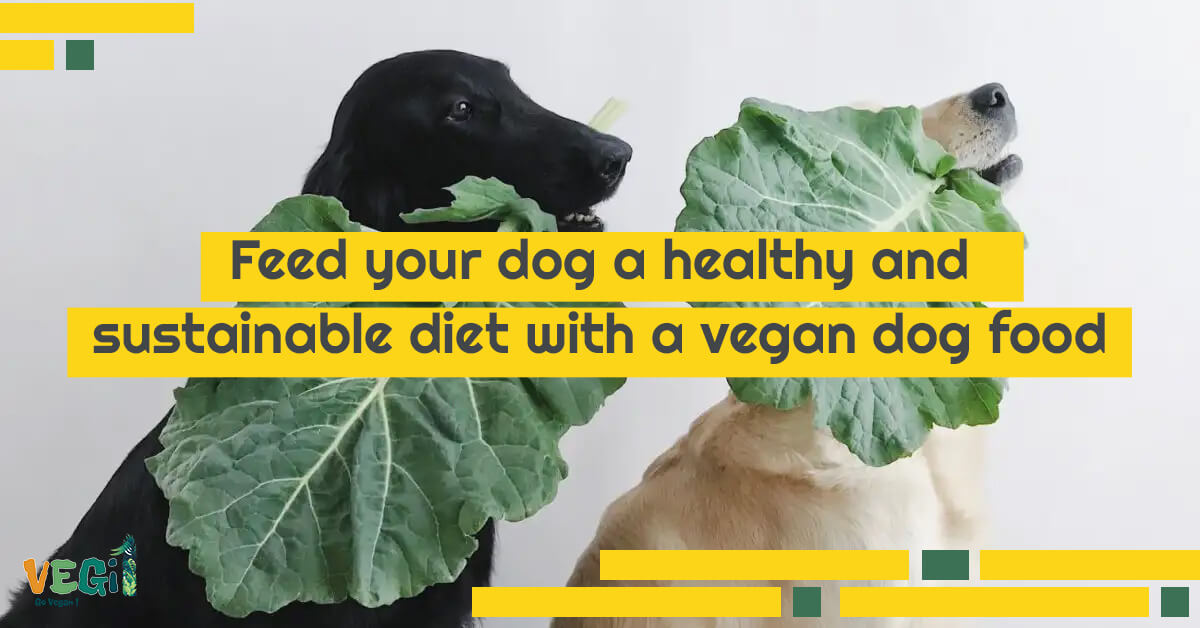
The results of scientific studies on vegan diets for dogs
The research:
The Axelsson group (2013).
“The genomic signature of dog domestication reveals adaptation to a starch-rich diet.”
In 2014, Arendt and colleagues. “Amylase activity is associated with AMY2B copy numbers in a dog: implications for dog domestication, diet, and diabetes.”
Ollivier et al. (2016).
“Amy2B copy number variation reveals starch diet adaptations in ancient European dogs.”
Melgarejo, Tonatiuh et al. (2023). “Domestic dogs maintain positive clinical, nutritional, and hematological health outcomes when fed a commercial plant-based diet for a year.”
The outcomes: Researchers at Uppsala University in Sweden, led by Erik Axelsson, found that dogs possess four to thirty copies of the AMY2B gene, which enables them to process starchy (plant-based) foods. Usually, wolves only have two copies. Paleontological evidence indicates that dogs have duplicated this gene for at least 5,000–7,000 years. These results suggest that early in their domestication, dogs adapted to diets that were comparatively high in starch.
“Evaluation of selected high-starch flours as ingredients in canine diets” was published in 1999 by Murray and colleagues.
Carciofi et al. (2009) “Effects of six carbohydrate sources on dog diet digestibility and post-prandial glucose and insulin response.”
2017; Cargo-Froom et al.
“227 Apparent and true digestibility of minerals in animal and vegetable ingredient based adult maintenance dog food.”
The outcomes: Dogs’ digestibility of corn, barley, potatoes, rice, sorghum, and wheat was examined by Murray and associates in 1999. They discovered that each had a digestibility of more than 99%. Similar findings were found for rice, corn, sorghum, cassava, brewer’s rice, peas, and lentils in a later study conducted by Carciofi. The study verified that starch digestibility exceeded 98%. Cargo-Froom (2017) examined the mineral digestibility of dogs fed meat versus dogs fed plant-based diets. According to their findings, dogs fed diets high in vegetables have endogenous mineral digestibility that is either the same or higher.
Table of pros and cons of a vegan diet for dogs
| pros | cons |
| Reducing the risk of cardiovascular disease, cancer, and obesity | May not be suitable for dogs of certain breeds or ages |
| Reducing environmental impact | The dog may suffer from nutrient deficiencies |
| Improve gut health | You may need supplements |
| Dogs live longer | The dog may have a lack of energy |
| Reduce the risk of diabetes | It costs more than a regular diet |
| Appropriate weight | |
| Reduce inflammation |
In the end,
If you want to feed your dog with a vegan diet like me, it can be said that if you pay attention to all the ingredients the dog needs, there will be no problem. I hope this article on the topic of how to feed a dog vegan diet was useful for you, and if you have any opinion or experience about this diet, tell me in the comments and rate me; thanks.
